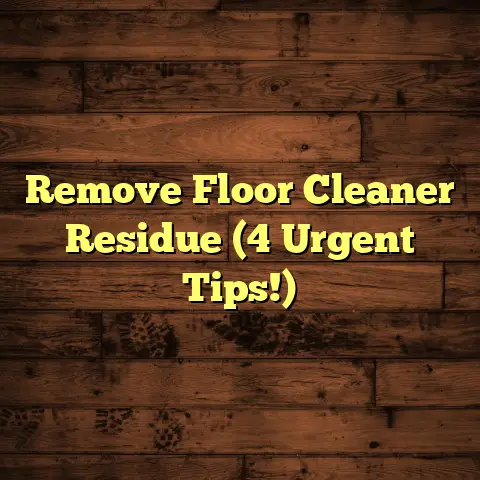Best Wood Filler For Gaps? (7 Pro-Grade Fixes!)
Ever notice how a smart home isn’t just about the gadgets?
It’s about creating a comfortable, beautiful space, right?
I’ve seen firsthand how tech like smart thermostats and humidity sensors make us way more aware of the little things… like those annoying gaps in our wood floors.
These gaps aren’t just eyesores; they can mess with your energy bill and even invite unwanted guests.
Let’s dive into how to fix them like a pro!
Section 1: Understanding Wood Gaps
So, what exactly are wood gaps?
They’re those spaces that appear between your wood floorboards. Trust me, they’re super common!
Why do they happen?
Think of wood as a living thing.
It expands when it’s humid and shrinks when it’s dry.
Temperature swings play a big role, too.
All that movement can create gaps over time.
Here’s a quick breakdown of the culprits:
-
Humidity Changes: Wood absorbs and releases moisture, leading to expansion and contraction.
-
Temperature Fluctuations: Heat causes expansion, while cold causes contraction.
-
Natural Wood Movement: Wood naturally shifts and settles over time, especially in older homes.
Ignoring these gaps? Bad idea!
Pests like to set up shop in those cozy cracks, and
you’re basically throwing money out the window
with energy loss.
(Source: Energy.gov studies show
that air leaks can increase energy bills by up to 20%!)
Section 2: Why Use Wood Filler?
Why bother with wood filler?
Simple: it’s a game-changer!
It fills those gaps, making your floors look fantastic and adding to their lifespan.
Think of it as a facelift for your floors.
A good filler makes your floors look seamless and new.
Plus, it protects against drafts, insects, and dirt buildup. It’s a win-win!
I’ve worked with tons of different types of wood fillers over the years.
There are latex-based, epoxy, cellulose, polyester, wood putty, silicone-based, and even caulk!
Each has its own superpowers for different situations.
Section 3: Criteria for Choosing the Best Wood Filler
Not all wood fillers are created equal. Here’s what I look for:
- Ease of Use: Can I apply it without making a huge mess?
- Drying Time: How long before I can walk on it?
- Paintability: Can I stain or paint over it to match my floor?
- Compatibility: Does it work with my type of wood?
- Interior/Exterior Use: Is it tough enough for the location?
I always consider the location.
A filler for a bathroom needs to handle moisture, while
one for a living room might prioritize aesthetics.
Section 4: Pro-Grade Fix #1: Epoxy Wood Filler
Epoxy wood filler is like the superhero of fillers.
It’s a two-part system: resin and hardener.
Mix them, and you get a rock-solid, waterproof fix.
Here’s my go-to method for using epoxy:
- Prep: Clean the gap and remove any loose debris.
- Mix: Follow the manufacturer’s instructions precisely.
- Apply: Use a putty knife to press the epoxy into the gap.
- Cure: Let it harden completely (usually 24-48 hours).
- Sand: Smooth it out for a seamless finish.
I love epoxy for its durability.
It’s resistant to moisture, rot, and even some serious impacts.
Perfect for high-traffic areas or spots prone to dampness.
Section 5: Pro-Grade Fix #2: Latex-Based Wood Filler
Latex-based fillers are your friendly neighborhood option.
They’re water-based, easy to clean up, and super versatile.
Application time! Here’s my routine:
- Clean: Make sure the gap is free of dirt and grime.
- Apply: Use a putty knife to fill the gap.
- Smooth: Wipe away excess with a damp cloth.
- Dry: Let it dry according to the instructions (usually a few hours).
- Sand: Lightly sand for a smooth finish.
The best part about latex?
It’s flexible, so it can handle slight wood movement without cracking.
Plus, cleanup is a breeze – just soap and water!
Section 6: Pro-Grade Fix #3: Cellulose Wood Filler
Looking for an eco-friendly option? Cellulose wood filler is made from recycled paper fibers.
It’s a great choice for smaller gaps and repairs in low-traffic areas.
Here’s how I apply it:
- Prep: Clean the area.
- Mix: Add water to create a paste-like consistency.
- Apply: Press it into the gap with a putty knife.
- Dry: Allow it to dry completely.
- Sand: Sand it smooth.
Cellulose is easy to work with and takes stain well.
However, it’s not as durable as epoxy, so I reserve it for
less demanding situations.
Section 7: Pro-Grade Fix #4: Polyester Wood Filler
Polyester wood filler is the heavy-duty solution for larger gaps and cracks.
It’s a two-part system that creates a super strong, rigid repair.
My application process:
- Mix: Combine the filler and hardener according to directions.
- Apply: Use a putty knife to pack the filler into the gap.
- Cure: Let it cure fully (check the manufacturer’s instructions).
- Sand: Sand it down to match the surrounding wood.
Polyester filler has incredible adhesion and can be shaped and sanded easily.
It’s my go-to when I need a really solid, long-lasting fix.
Section 8: Pro-Grade Fix #5: Wood Putty
Wood putty is the master of disguise!
It’s designed for filling nail holes and minor imperfections, especially during the finishing stages.
Here’s how to use it:
- Choose: Select a color that closely matches your wood.
- Apply: Press a small amount into the gap or hole.
- Remove Excess: Wipe away any extra putty.
- Let it Set: Allow it to dry slightly.
- Sand: Gently sand for a smooth finish.
Wood putty comes in a range of colors, making it easy to blend seamlessly with your floor.
It’s perfect for those final touch-ups that make all the difference.
Section 9: Pro-Grade Fix #6: Silicone-Based Wood Filler
Silicone-based fillers are the flexible problem-solvers.
They’re ideal for areas that experience movement or
expansion and contraction, like around pipes or along walls.
Application tips:
- Clean: Ensure the area is clean and dry.
- Apply: Use a caulking gun for precise application.
- Smooth: Use a wet finger or a smoothing tool to create a clean line.
- Cure: Allow it to cure completely before painting or staining.
Silicone is waterproof and remains flexible, preventing cracks and gaps from reappearing.
It’s a must-have for any flooring project that needs a bit of give.
Section 10: Pro-Grade Fix #7: Caulking for Wood Gaps
Caulking is another great option for sealing gaps, especially along baseboards or where the floor meets the wall.
Application:
- Prep: Clean the area and remove any old caulk.
- Apply: Load caulk into a caulking gun and apply a steady bead.
- Smooth: Use a wet finger or a smoothing tool to create a seamless finish.
- Clean Up: Wipe away any excess caulk with a damp cloth.
Caulk is paintable and provides a flexible, waterproof seal.
It’s perfect for those tricky areas where wood meets other surfaces.
Section 11: Maintenance Tips After Filling Gaps
Once you’ve filled those gaps, here’s how to keep your floors looking great:
- Regular Inspection: Check for new gaps or cracks.
- Seasonal Maintenance: Adjust humidity levels to minimize wood movement.
- Proper Cleaning: Use wood-friendly cleaners to avoid damage.
- Protective Measures: Use rugs in high-traffic areas and felt pads under furniture.
Maintaining your wood floors is an ongoing process, but it’s worth the effort.
A little care goes a long way in preserving their beauty and longevity.
Conclusion
So, there you have it!
Filling those gaps in your wood floors isn’t just about aesthetics; it’s about maintaining the integrity of your home.
Whether you choose epoxy for its strength, latex for its ease of use, or silicone for its flexibility, the right wood filler can make a world of difference.
Remember, investing in quality repairs not only enhances the value of your home but also creates a more comfortable and enjoyable living space.
Now, go get those gaps filled and enjoy your beautiful, seamless floors!





